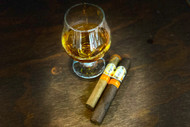Rare Cigars: Casa 1910 Revolutionary
Posted by Ana Cuenca on Oct 17, 2022
Rare Cigars: Casa 1910 Revolutionary
In 2010, a half-finished stogie sold at auction for $6,000.
No, we're not pulling your leg.
This half-finished cigar was previously enjoyed by former British Prime Minister Winston Churchill before he had to urgently attend a wartime Cabinet meeting.
In a rush, he left half of a cigar behind to be (unknowingly) collected and sold decades later.
This situation is just one example of a rare cigar and how valuable it can become.
However, there are many types of rare cigars on the market today. One of these is the Casa 1910 Revolutionary.
Here we're breaking down what makes cigars rare and giving you more information on the unique Casa 1910 Revolutionary.
What Makes a Cigar Rare?
While many cigars may seem similar on the surface, there is an entire world of difference beneath their soft wrappings.
Year and Maturing Time
As you saw with the half-smoked stogie of Winston Churchill, the year a cigar was produced lends to its rarity.
This is similar to fine wine: the older the bottle, the rarer it typically is.
However, the actual age of a cigar isn't the only aspect that can increase its rarity. A cigar can also become rare if it is memorializing a certain historical event or date.
A great example of this is the Casa 1910 Revolutionary, which memorializes the first battles for Independence in Mexico.
Along with actual age and memorialized events, how long a cigar matures also increases its rareness and value.
The maturing process begins after a cigar is rolled and helps develop its unique flavor profiles. Taste generally improves over time, which is why cigars that matured for longer are considered rare.
Another example of aging in different types of cigars is the age of individual ingredients. Arturo Fuente cigars feature a top-quality Dominican wrapper that has been aged for years, giving the cigar its unique mellow aroma.
Ingredients, Blending, and Geography
The region and quality of ingredients used to make a cigar also highlight how rare it is.
If a cigar is made exclusively with tobacco, spices, or other materials from a specific region, it can make the cigar rare. This is especially true if these ingredients only grow in one geographical area.
This is one of the reasons specific Cuban cigars are favored. Many of the most-loved flavor profiles result from the blends and blending methods unique to Cuba.
However, other regions of the world create cigars using only local ingredients, resulting in a rare flavor different from Cuban cigars.
The final construction and appearance can also help create rare cigars. Width, smoothness, weight, and design can increase quality and prestige.
Production Limitations
Another reason some Cuban cigars have been considered rare is due to the country's production limitations throughout the years.
If production is limited for a cigar, it naturally becomes rarer than those that don't have production limitations.
Another example of political influences affecting production and rarity is pre-Embargo Cuban cigars, which haven't been produced since the early 1990s.
Hand Rolling
As machine production of standard cigars has risen, the hand-rolled varieties have become rarer.
Hand-rolling and blending are traditionally longer processes, naturally creating a smaller supply. Unlike machines, human hand-rolling can only produce so many cigars at a time.
Hand-rolled cigars are also seen as superior in quality due to the care hand-rollers take in the design and craftsmanship.
Rare Cigar Collectors See Cigars as Investments
Believe it or not, huge markets exist for rare cigar collectors across the Far East and Europe. These collectors view rare cigars as investments, which only increases their appeal.
Once a rare cigar investment is purchased (and possibly consumed), it creates an even more limited supply of that particular cigar. This then drives up its value.
As you can see, this can turn a semi-rare cigar into a very rare cigar simply because it is owned solely by investors interested in cigar smoking.
The Casa 1910 Revolutionary
The Casa 1910 Revolutionary is the epitome of a rare cigar due to its concept, blend, and geography.
Its name is in memory of the first battle fought for Mexican Independence. This gives it a meaningful essence common to rare cigars.
Aside from history, the Casa 1910 is also handmade in Mexico, where its tobaccos age for five years. Each cigar is then rolled and matured for a minimum of six to eight months.
Additionally, the entire cigar, including the filler and wrapper, is made from tobacco grown in the fertile volcanic soils of the San Andres valley in Mexico.
Casa 1910: Flavor of the Revolution
Due to its exclusive production in Mexico with Mexican tobacco, the 1910 Revolutionary also offers a unique flavor profile.
The rich, volcanic soils of the San Andreas valley lend a sophisticated complexity unique to the region. This includes notes of warm wood, pepper, spice, and a tinge of chocolate.
Since this flavor profile is produced exclusively using Mexican tobacco, its taste is naturally rare.
Fine and Limited Edition Rare Cigars
At Cuenca Cigars, we're committed to offering quality, rare and hard-to-find cigars. Our extensive collection of cigars from around the world highlights brands renowned for their craftsmanship.
All our cigars are stored in a humidity-controlled room in small batches in to guarantee freshness.
From the best Dominican cigars to Limited Edition cigars, we have one of the largest collections in the industry.
Browse our rare cigars collection online, including the Casa 1910 Revolutionary, or stop by our physical store in Hollywood, Florida.

